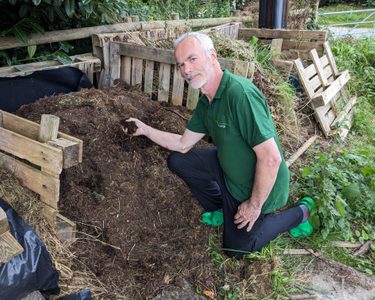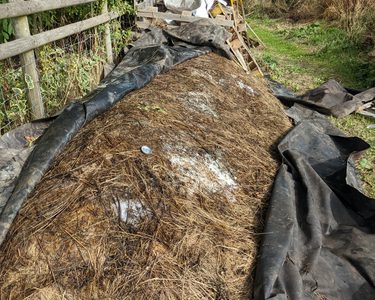Large scale bokashi experiment

Our Shropshire Master Composter Steve has been discovering how meadow hay bales can be composted using a large-scale fermenting method.
The basic ingredients are the same: layering green and brown materials like a lasagne, with each layer around 30cm thick. To this Steve adds water and additional elements to kickstart the anaerobic fermentation process, such as a liquid feed and ground-up seashells, which are a rich source of calcium.
The entire heap is then covered in heavy duty black plastic so no air can get in and is left for six to eight weeks. The method could potentially be applied to livestock bedding, including animal waste, and retail food waste. Thick layers of cardboard, weighed down with something heavy to compress the pile, could be used instead of plastic sheets.
Alongside project sponsors Agriton, and local Master Composters, the trials have already revealed that even at this large scale, the bokashi system results in not only a greater weight of useable compost but also compost that is richer in a wide range of elements that are important for promoting plant health.
This method also offers some practical advantages over traditional composting, including being less labour intensive (no need to turn the compost to aerate it) and producing compost in just a few weeks.
Read Steve's more detailed report below.
We’re grateful to Agriton for their support and sponsorship of this experiment. Visit agriton.co.uk for more information.
A viable alternative to traditional composting
By Steve Griggs
Bokashi is a great way to treat food stuff that can't be added to my compost bin - but because it doesn't yield large volumes of material, I didn't see it as a viable alternative to traditional composting. All that changed when I took part in a Garden Organic webinar led by Martyn Richards of Agriton, which has developed a method of composting large volumes of material using the bokashi system.
Trials conducted by Agriton reveal that the Bokashi system results in not only a greater weight of end product but, more importantly, greater amounts of organic matter, carbon and nitrogen and energy (see Figure 3 below). In contrast, traditional composting releases significant volumes of CO2 and water (in the form of steam as the pile warms up).
A potential downside of the Bokashi system is that some of the ‘browns’ I normally add to my compost will not ferment and so cannot be added, including my mainstays, cardboard and paper.
I have a small wild flower meadow (less than half an acre), which has to be cut each year and the cuttings removed. I've been trying to compost the material in the usual way but this has proved challenging because of the volume of mainly brown material (about 18 mini bales). Martyn very kindly agreed to come along and help me set it up as a pilot large-scale bokashi system.
The meadow was cut in late August and the hay baled. In early September, I met up with Martyn and fellow Master Composters Jerry and Mark to see what we could do.
Adding extra ingredients
The bokashi system of composting is anaerobic, which means we don’t have to turn it and it should result in a useable end product in about 12 weeks, so it is quicker and less labour intensive compared to traditional composting. Given that the Bokashi system is an anaerobic process, we needed to add additional materials to kick start the fermentation process that will decompose our materials:
- Actiferm: a brown liquid containing ‘effective micro organisms’ (EMOs) including lactic acid bacteria, fungi and yeast. Actiferm can also be used in a ‘traditional’ compost bay to speed up the rate of decomposition.
- Aegir: ground up seashells (a waste product from the sea food industry), a rich source of calcium (CaCo3) which stabilises the pH and feeds the soil with a wide range of minerals and trace elements.
A third, optional material can also be added:
- Edasil: very fine clay particles that bind together a large amount of water and nutrients. In addition, it contains all the essential micro-elements.
Three-bay system
The plan was to use three of my composting bays, each approximately one cubic metre in volume:
- Bay 1: hay, grass cuttings, water, Actiferm and Aegir.
- Bay 2: as for Bay 1 with the addition of Edasil.
- Bay 3: hay, grass cuttings and water i.e. a traditional compost mix as a point of comparison.
We built up the three bays using the ‘lasagne’ method: a layer of brown material (hay) followed by a layer of green (grass cuttings) in equal proportions, we then sprinkled on a good handful of Aegir in Bays 1 and 2, and, for Bay 2, a handful of Edasil. We diluted roughly 1 litre of Actiferm in 10 litres of water.
Ideally, rainwater would be used as tap water contains chlorine, which is harmful to microbes but following a very dry summer we had to use tap water so we made sure this was well aerated when mixed with the Actiferm. Using a rose sprinkler, the diluted Actiferm was added to the pile. We repeated this layering process until the bays were full. At this point, each Bay contained roughly 1 tonne of material.
We still had a large amount of hay left over so we then created a windrush adding water, Actiferm, Aegir and Edasil.
All three bays had been lined with black plastic. Once filled, Bays 1 and 2 were then covered with plastic. Bay 3 was left open to the elements (the way I normally go about composting). The windrow was covered with heavy duty black plastic. We then left everything for some 12 weeks.
Weighting the heap
My plan was to turn the regular compost mix but things got in the way which meant I only managed to turn it on a couple of occasions. I recorded the temperature of the materials on these occasions with the following results.
Given that the bokashi system should be anaerobic, the increase in temperature in Bays 1 and 2 and the windrow was not expected and was probably caused by air pockets resulting in an aerobic condition. I subsequently weighed down Bays 1 and 2 with heavy paving slabs to compress the ingredients. In future, this is something I will need to do from the start of the process.

Results after 12 weeks
Martyn paid me another visit in December 2022, some 12 weeks later, to check on progress. At first glance, the material in the two bokashi bays looked quite similar to the way it had at the start.
It also didn’t look anything like the compost I normally end up with. It looked very much like hay albeit somewhat discoloured. However, whereas it's almost impossible to tear hay apart by hand, the material we now had was very easy to pull apart. This was because the process of fermentation had broken down the cell structure. The end result was now ready to be used as a soil improver. In contrast, the traditional compost, although it had started to decompose, was still a long way from being compost.
The windrow also looked very much like hay, but unlike the product from the two bokashi bays, it was difficult to pull apart. This was a consequence of the lack of any green material. On a positive note, it had started to break down and, with luck, should eventually decompose sufficiently for me to use.
End product samples
Martyn took samples of the end product from Bays 1, 2 and 3 which he arranged to be analysed. The results are summarised below. It should be noted that care is needed when interpreting the findings as we did not precisely measure the quantities of the various ingredients.
The pH was similar across all three conditions. Given that Actiferm has a pH of around 4, this confirms that one of the benefits of adding Aegir is to adjust the pH of the end product.
The dry matter of plant and animal material consists of all its constituents excluding water. When water was taken out of the samples, what was left to go back into the soil was less for the traditional compost compared to the bokashi compost.
The levels of nitrogen (greens up plants), potassium (promotes all around wellbeing) and phosphorous (reaches down to the roots and helps increase yield) were lowest in the traditional compost. Nitrogen and Potassium levels were higher in the Actiferm/Aegir seashell grit condition (Bay 1).
Levels of sulphur and magnesium were higher in the two bokashi compost conditions compared to the traditional compost. Sulphur is an essential plant nutrient. It's required for the production of amino acids, which make up the proteins critical to plant growth. Magnesium is the central core of the chlorophyll molecule in plant tissue. Thus, if it is deficient, the shortage of chlorophyll results in poor and stunted plant growth. Magnesium also helps to activate specific enzyme systems.
Calcium levels in the bokashi system
Not surprisingly, Calcium levels was higher for Bokashi compost samples due to the added seashell grit.
Calcium plays several key roles in promoting plant health. By loosening up soil, it increases water penetration ability, water-holding capacity, and aeration ability. Oxygen is required by soil life, thus the more oxygen available, the more soil life which can be supported. Calcium is essential to healthy cell walls, affecting both permeability and strength. It acts as a buffer/carrier for some other nutrients and enhances uptake of water and promotes root and leaf development. It can improve the effectiveness of other fertilizers applied, such as nitrogen, phosphorus, potassium, and other essential nutrients.
Conclusions
In summary, compost produced using the bokashi method yielded an end product that held onto a greater proportion of the dry matter and was richer in a wide range of elements that are important for promoting plant health.
On the downside, there are the added costs of the Actiferm (£56 for 50l), Aegir (£8.40 for 3kg) and Edasil (£14 for 3 kg). Certain ‘brown’ ingredients that many of us probably use as a key ingredient cannot be used, including cardboard and paper.
But the system offers some practical advantages over traditional methods, including being less labour intensive (no need to turn the compost to aerate it) and produces an end product in just a few weeks, a time period that even ‘hot’ composting would struggled to better.